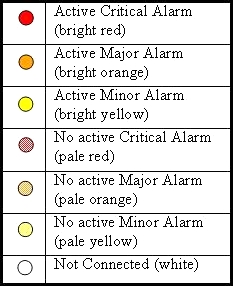| User Data Repository Alarms, KPIs, and Measurements Release 12.4 E82598-01 |
|
 Previous |
 Next |
Events note the occurrence of an expected condition, such as an unsuccessful login attempt by a user. Events have a severity of Info and are logged on the View History page.
Figure 3-1 shows how alarms and events are organized in the application.
Figure 3-1 Flow of Alarms

Alarm indicators, located in the User Interface banner, indicate all critical, major, and minor active alarms. A number and an alarm indicator combined represent the number of active alarms at a specific level of severity. For example, if you see the number six in the orange-colored alarm indicator, that means there are six major active alarms. This is shown in Figure 3-2 and Figure 3-3.
Figure 3-2 Alarm Indicators Legend

Figure 3-3 Trap Count Indicator Legend
